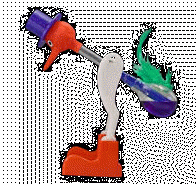|
Sankey Diagrams and Efficiency
Objectives
• Know that some of the energy used by a device is
wasted.
• Be able to draw Sankey diagrams to show the amounts of
useful and wasted energy produced by a device.
• Be able to calculate the efficiency of a device, given
information about the energy input and useful energy output.
Task 1 - Numeracy
Discuss with the person next to you:
• What is ¼ as a decimal? What is ¼ as a
percentage?
• What is 75% as fraction? What is it as a
decimal?
• What is two thirds as a decimal? What is it as
a percentage?
• What is 0.1 as a fraction? What is it as a
percentage?
• What is 0.4 as a fraction? What is it as a
percentage?
Task 2
In order to evaluate how efficient a device is, we
need to look at the amounts of useful and wasted energy. Complete
the table below with the missing values:
|
Device |
Total energy input
(J) |
Useful energy output
(J) |
Wasted energy output
(J) |
|
Energy efficient lightbulb |
12J electrical |
3J
light |
|
|
Incandescent lightbulb |
100J electrical |
|
90J heat |
|
coal power station |
________ chemical |
500MJ Electrical |
1000MJ heat + sound |
|
nuclear power station |
2000MJ nuclear |
500MJ Electrical |
_______ heat + sound |
|
Toaster |
|
900J useful heat |
100J wasted heat + light |
|
Photovoltaic (solar) cell |
20J light |
|
15J reflected light + wasted heat |
|
Kettle |
|
1600J useful heat |
400J wasted heat + sound |
|
Laptop computer |
60J electrical |
20J light + sound |
|
A copy of the table for students is available
here as a word document.
Task 3
Sankey diagrams show energy transfers, using scaled
arrows to represent the amounts of useful and wasted energy. Your
teacher will show you how to draw a Sankey diagram for the energy
efficient lightbulb on the graph paper below.

Pay attention to the example, and then complete Sankey
diagrams for the following devices. The scale has been given to
you in each case.
• Energy efficient lightbulb - (3
Joules per square)
• Coal power station (500MJ
per square)
• Kettle (400J per square)
• Laptop computer (20J per
square)
• Incandescent lightbulb (100J
per square)
You will need to choose a suitable scale for each one!
Task 4
Your teacher will explain the idea of efficiency
to you and explain to you how efficiency is calculated. Calculate
the efficiency of each device in your table. Show full working for
each of your calculations.
|

